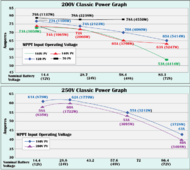Fenachrone
New Member
- Joined
- Sep 26, 2021
- Messages
- 39
Question 1: I have an Outback MX60, but with the addition this spring of several new and more powerful panels to my system, have decided (based on advice here) I'll need to add a new charge controller.
I have a LiFePO4 battery bank, for which the MX60 isn't superbly well matched, but it's been working OK. I'd like to add a Midnite Solar Classic (200 SL or 250 SL). Can these two play together in managing battery charging?
Question 2: I'm having a bit of trouble determining what the difference is when making a choice between the 200 SL and 250 SL. The 200 is rated for more amps (65-74 for the 200, vs 55-60 for the 250), but the 250 is rated for for more voltage (250 vs. 200, of course). Under what circumstances do these differences become important? Or is it all about the MAX VOC?
I have a LiFePO4 battery bank, for which the MX60 isn't superbly well matched, but it's been working OK. I'd like to add a Midnite Solar Classic (200 SL or 250 SL). Can these two play together in managing battery charging?
Question 2: I'm having a bit of trouble determining what the difference is when making a choice between the 200 SL and 250 SL. The 200 is rated for more amps (65-74 for the 200, vs 55-60 for the 250), but the 250 is rated for for more voltage (250 vs. 200, of course). Under what circumstances do these differences become important? Or is it all about the MAX VOC?



